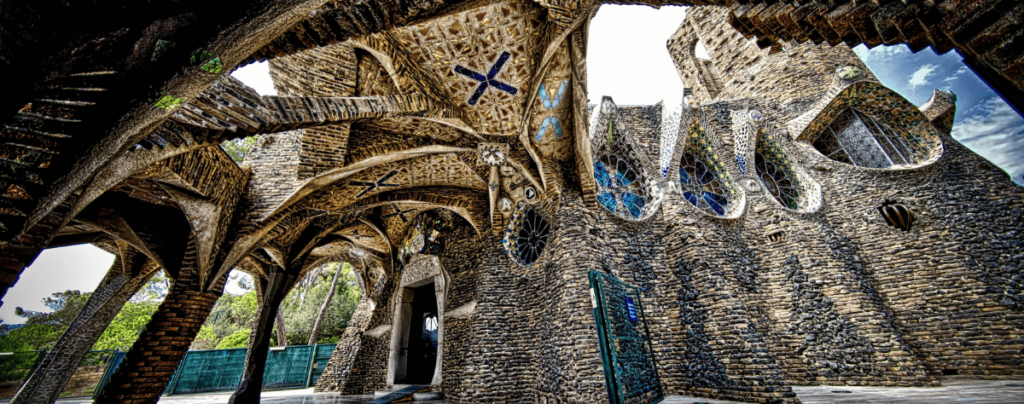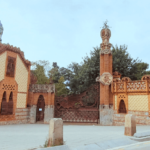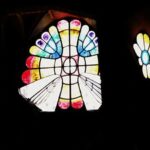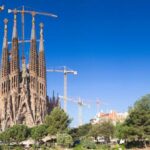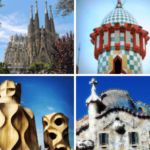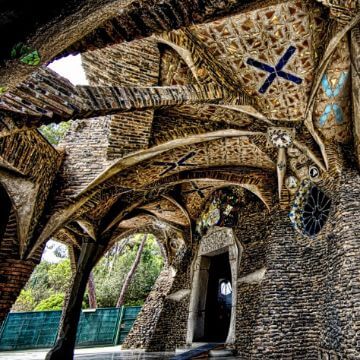
Insider tips to plan your visit to La Colonia Guell Gaudi Crypt
YOUR GUIDE TO THE COLONIA GUELL CHURCH
Barcelona was one of the most important poles of the Industrial Revolution in Spain. At the beginning the factories piled up in the subburbs of the city, attracting thousands of poor peasants to work as labor in very hard living conditions. But soon anarchism started stirring up the violence of the working class agains their patrons. And industrial Colonies such as Colonia Guell appeared as a means to keep their workers controlled and isolated from the anarchist influences.
An industrial colony was a sort of community organized around a factory, where the workers were provided housing, education for their children, access to cultural activites and religious services and affordable food and home supplies. A worker should never feel the need of leaving the industrial colony to fullfill their basic needs. Named after their patron and owner, Colonia Guell is one of the best examples of industrial colonies you can explore near Barcelona. With the bonus of visiting one of the most remarkable Antoni Gaudi’s hidden gems: Cripta Guell, the village church.
Basic facts about La Colònia Güell
1
Brief summary of the Colonia Guell history
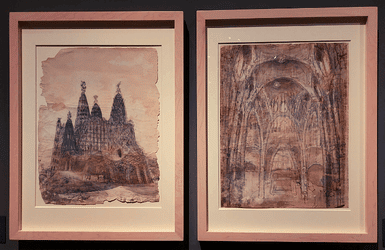
Joan Güell, father of Eusebi Güell - Antoni Gaudi's patron and best friend, founded the textile factory Vapor Vell in 1848, in the Barcelona subburb of Sants. Soon violence arises, and during a general strike the manager of the factory was killed in a riot. Some years later Joan Güell purchases a large state in the town of Santa Coloma de Cervello, not too far from Barcelona. There his son would promote the construction of a new factory with an adjacent industrial colony when his father passed away: the Colonia Guell.
Antoni Gaudi designed the urbanism of the village, based on three key points: the factory, the church and the school, each in one end of it. His collaborators Francesc Berenguer and Joan Rubió worked also on the project, that included coooperative shops, health services, a theater, a community center, a school with a home for the teacher, as well as a parish church – this last one to be built by Antoni Gaudi himself.
The community lived quite peacefully and satisfied, and the workers didn’t cause remarkable issues, rather feeling attached to the factory and helping to keep it open during the Spanish Civil War. The Guell Colony changed hands during the 1940’s, until its final closing in the 1970’s due to the economical crisis. In 2002 the factory building was acquired by a dutch company that refurbished for office purposes and the Gaudi Crypt was restored. The rest of the colony has become a trajquil working class village.
2
Architecture of the Church of Colonia Guell by Antoni Gaudi
As you walk under the portico, looking up you see how Gaudi decides to stand out these parabolic shapes through the use of triangular colored tiles. A huge mosaic over the church door is full of Christian symbolism related to the Virgin Mary and the Christian Vertues. The columns and the outside of the crypt are made of limestone from the quarries own by Guell and trash metal from nearby factories. The window grids are made of broken looms from the Guell factory – Gaudi loved reclycing materials and using them in unexpected ways!
The interior of the Guell Crypt surprises for its simplicity: coarse unpolished stone columns supporting brick arches that stem of them as if they were branches of a tree. Stained glass windows provide a subdued light of a spiritual quality. The windows look like daisys when they are closed, but when they are open they look like butterfly wings. The church pews were also Gaudi’s design, and were conceived to be only confortable as long as the person seating would be respectfully following the service rather than chatting with their neighbor.
Back outside, a newly added staircase allows you to reach the current rooftop of the church – now a balcony over the Colonia Guell state. But it shouldn’t have been: the current church was going to be only a secondary chapel to the main church that should have been what now is the rooftop. That’s why people call this building also the “Cripta Guell” or Guell Crypt: it was meant to be only a basement chapel, as it’s partly under the hill behind it. Nowadays only the white stone frame of a gate stands testimonial of what should have been.
Visiting the Guell Colony
3
Cripta Gaudi: Interpretation Center and Gaudi Crypt
Your visit of the Cripta Guell shouldn’t start in the church, but in the number 6 of Claudi Guell street. There the old headquarters of the workers cooperative has become an Information Point and Interpretation Center of Colonia Guell and the Gaudi Crypt. Your ticket to the Church includes admission to the Interpretation Center, so do not skip it. It’s a great introduction to the history of the factory, the colony inhabitants and Gaudi’s architecture. And you’ll be fascinated to see a replica of the hanging model that the architect used to create his first self-supporting building. The visit typically lasts less than 30 minutes. TIP: It’s a good opportunity for toilet stops and gift shop!
From there you’ll be only one minute walk from the Colonia Guell church. Tourist visits are not allowed during services, and outside of services the entrance is paid. So make sure to buy your tickets in advance. After crossing the gate, take your time to relish on its peaceful outside, the architecture colors and shapes melting into the surrounding nature. Enjoy looking at the details of the mosaics and the beauty of the discarded materials used in the construction.
Then step in and seat in one of Gaudi’s pews to feel like one of those workers of the Industrial Revolution. Feel your spirit raise to the brick arches on top of you. Be mesmerized by the sunlight filtering through the stained glasses. If you’ve been to Sagrada Familia or La Pedrera, try to see the connections of these buildings with this Crypt. And when you are ready, walk around to explore the rest of the church decoration.
Back to the garden outside, walk around the belltower to find the modern staircase that takes you to the rooftop where the main church was meant to be. Use your imagination to evoke the rest of the building that could have been in your mind, and enjoy the view over the nearby colony homes and the surrounding pine tree forest.
4
Exploring the rest of Colonia Guell
If you have the time and are curious about the concept of an Industrial Colony, take the opportunity to explore the rest of Colonia Guell before heading back to Barcelona. Most buildings aren’t open to the public, but it makes for a nice stroll. Find Can Soler de la Torre, the state manor where the Guell stayed when they were visiting. The house of the Secretary, with a bat sculpted over the door (a symbol of king James I and part of the Guell’s coat of arms, that made the workers joke saying the Secretary was a vampire that suked their blood). The school, still in use, and the house where the teacher lived, now a kindergarten. The Ateneu and the Theater, in the square where stands a statue of Eusebi Guell. And the humble single-family dwellings of the workers, still used as housing nowadays.
Colonia Guell Church Logistics and Tips
5
How to get to La Colonia Guell in Santa Coloma de Cervelló
DRIVING
The Colonia Guell is a suburb of the village of Santa Coloma de Cervello, around 16.5 km (10.5 miles) West of Barcelona. If you decide to drive, it’ll take you just under half an hour on the A2 road. The closest exit is the 607, then continue via de C-245 and BV-2002. But if you miss it, don’t panic: it’s equally easy to reach it from the next exit, the 602, then join the BV-2002. Check out this GoogleMaps for more precise directions.
TRAIN
Taking the train is the most common option if you don’t have a car. The FGC trains depart from Plaça Espanya, with the lines S3, S4 and S8 taking you to Colonia Guell in a mere 22 minutes – 11 stops. The train frequency is irregular, though: departures can be between 5 and 20 minutes appart. The station of Colonia Guell is just outside of the colony, a bit over 5 minutes walk from the Interpretation Center, and even closer from the Guell Church.
BUS
Yes, there are suburban buses taking you to Colonia Guell (Santa Maria de Cervelló). But why bother? The train is so convenient! But in case you are adventurous, have plenty of time to waste and love observing the locals going on their errands, you can take the L61. It has several stops along the upper Diagonal Avenue, and it takes about 1 hour to take you there, stopping at every single town on the way…
BE TAKEN THERE
You know what? Sometimes you don’t want to worry about figuring out your way around, the train schedules, getting oriented… You are on vacation, and you don’t want all the work! The solution: be taken there, take a tour! Either you join a group of other tourists, or you have a larger budget that allows you to treat you to a private tour, havind a pro taking you there and taking care of everythign is the way to go. See below.
6
Private Tours of Gaudi Cripta Guell
PALAU GUELL TOUR WITH OPTIONAL COLONIA GUELL CRYPT
COLONIA GUELL CRYPT AND MONTSERRAT TOUR
COLONIA GUELL CRYPT AND ARTIGAS GARDENS TOUR
7
Where to eat near the Colonia Guell Gaudi Crypt
- El Capritx. The nicest choice within the Guell Colony is this homey restaurant with a modernist touch, serving elaborated Catalan food.
- Bar Sport. The former Can Serra is now Bar Sport. Lovely tapas, sandwiches and confort food. Lovely outdoor terrace with views over the brick building of the Ca l’Ordal farmhouse manor, and with a children playground accross the street making it perfect for families.
- Bar Restaurant Ateneu-Unió. The community center of the industrial colony continues to be a meeting point for the neighbors and a cultural center. Its bar is a perfect place for a drink and some snacks, or to enjoy moderately priced “menu del dia” day specials.
Will you be visiting the Church of Colonia Guell by Gaudi?
Marta
RESEARCHING FOR A TRIP IS TIME-CONSUMING…
Need more inspiration?
Our 100% FREE Barcelona Collection will give you everything you need to organize the trip of your lifetime to Barcelona.
BEST INSIDER TIPS FROM THE PROS!


